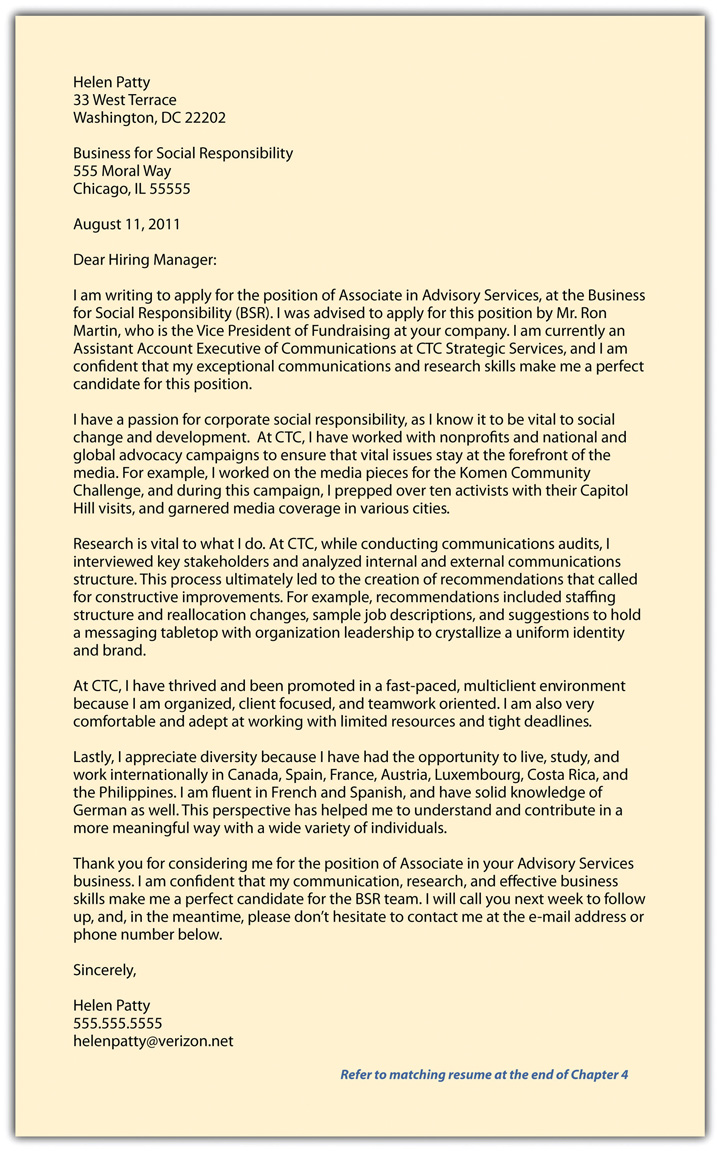This is “Step 2 (Continued): Create a Compelling Marketing Campaign, Part II: Cover Letter, Pitch, and Online Profile”, chapter 5 from the book Job Searching in Six Steps (v. 1.0). For details on it (including licensing), click here.
For more information on the source of this book, or why it is available for free, please see the project's home page. You can browse or download additional books there. To download a .zip file containing this book to use offline, simply click here.
Chapter 5 Step 2 (Continued): Create a Compelling Marketing Campaign, Part II: Cover Letter, Pitch, and Online Profile
Figure 5.1 The Six-Step Job Search Process—Step 2
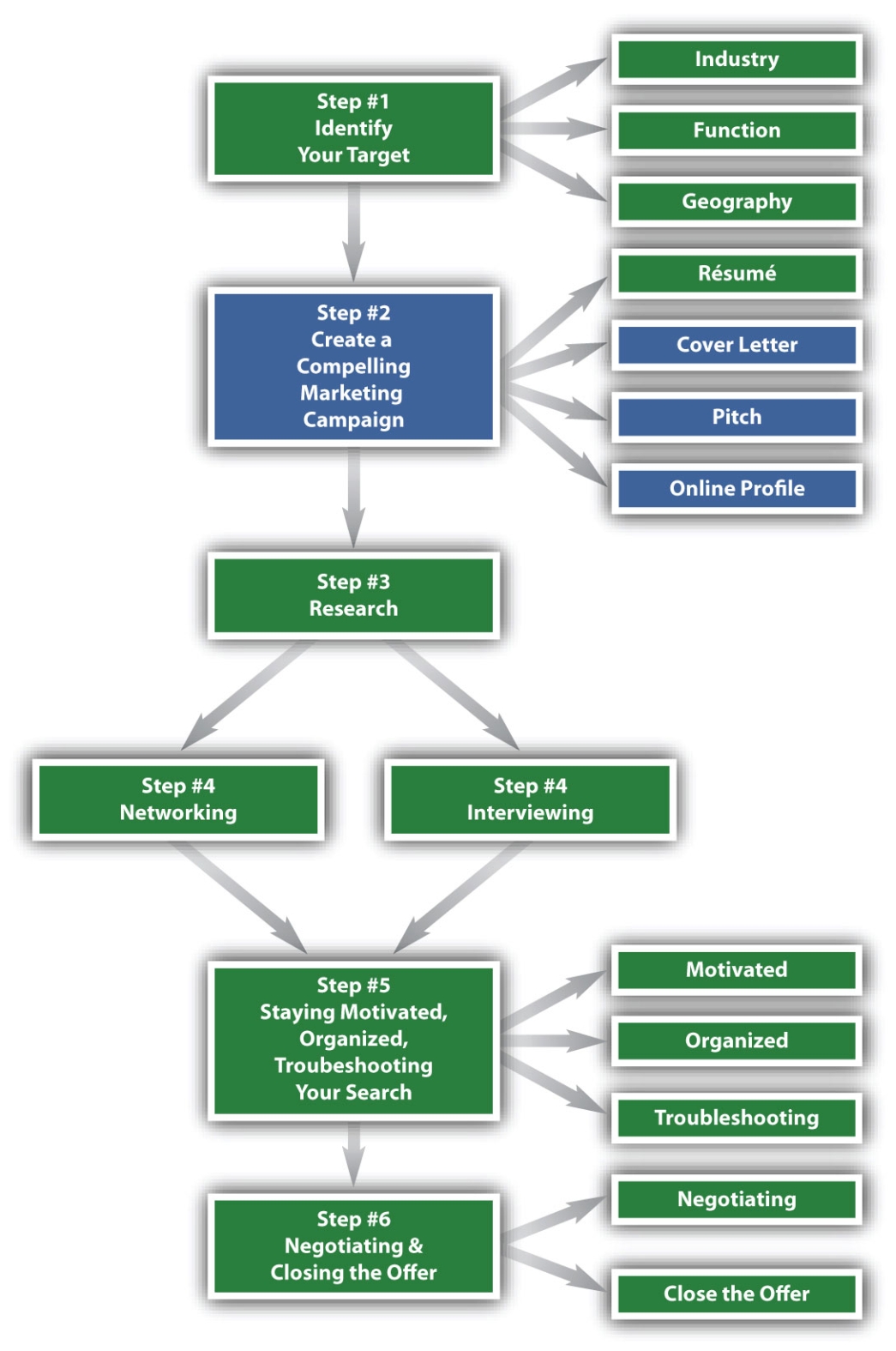
Overview
A Compelling Marketing Campaign Is More Than a Résumé
At this point in your search, you have completed Step 1, Identifying Your Target, by focusing on a specific industry, function, and geography.
You have also completed half of step 2 (create a compelling marketing campaign) by creating your résumé.
Now it’s time to complete your marketing campaign, which will create additional job search tools that will get the attention of your target companies and identify yourself as the best candidate available—that is, the person who can produce for them in a meaningful way.
The marketing component of your job search should be compelling, innovative, and of the highest quality. Think about how Apple markets their products. At first sight of the Apple logo—an apple with a bite out of it—you think of a sleek, innovative, quality product. You know that consumers are enjoying Apple iPads and iPods whether they are in New York or New Zealand, in the United States or in the United Kingdom—the marketing is that ingenious.
It should be the same with the remainder of your job search marketing campaign. A prospective employer’s impression of you should be crystal clear in terms of the quality associated with your name, your abilities, and your overall candidacy, even before they meet you. Your marketing campaign will set the stage for these quality interactions, especially step 4 (networking and interviewing) and step 6 (negotiating and closing the offer). But let’s not get ahead of ourselves.
Creating a compelling marketing campaign is composed of four distinct tools that can construct a strong, effective, and successful job search:
- Your résumé (which was covered in Chapter 4 "Step 2: Create a Compelling Marketing Campaign, Part I: Résumé")
- Your cover letter
- Your online profile
- Your networking pitch
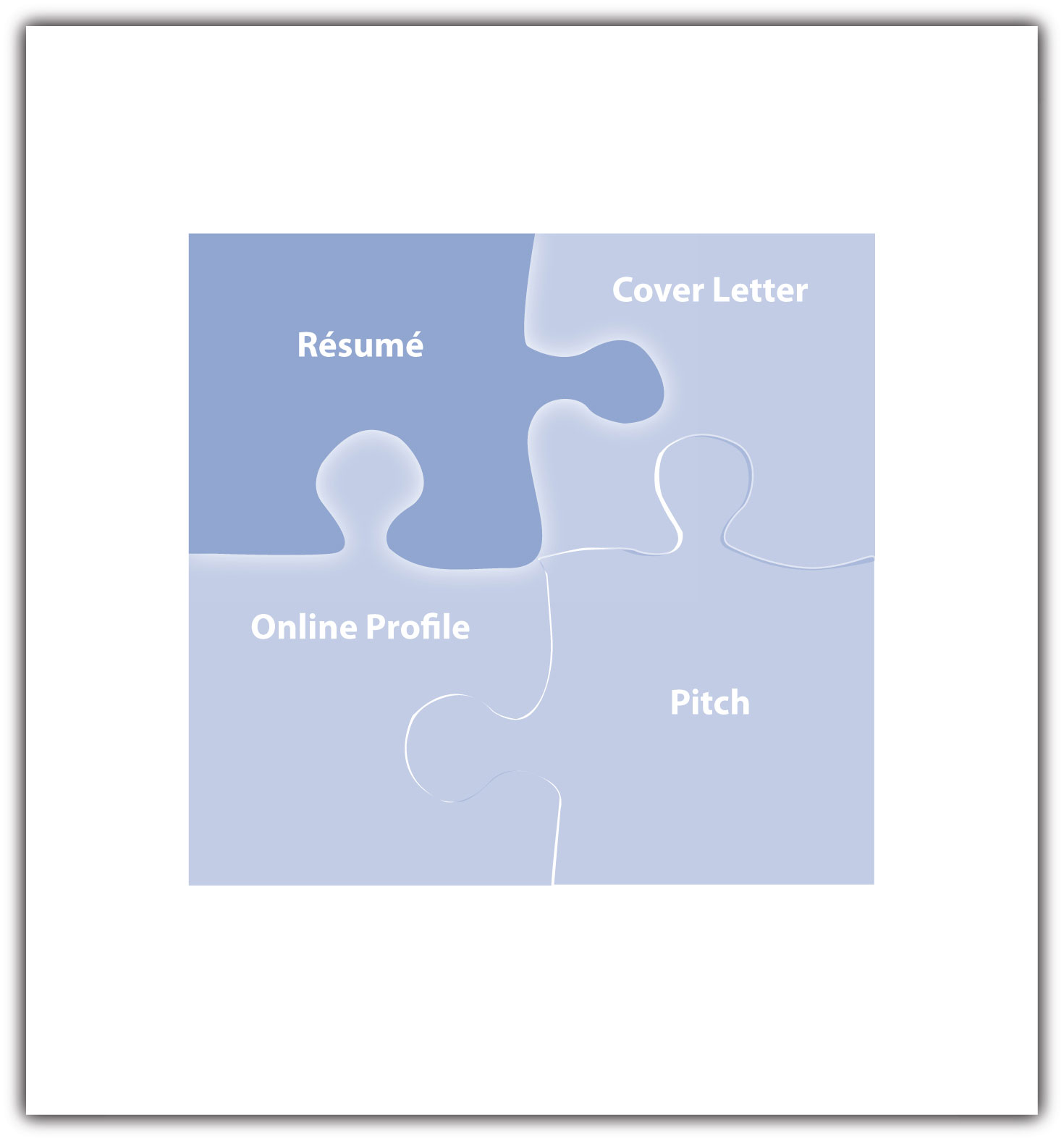
It’s important to note that Step 2, Create a Compelling Marketing Campaign, is the second step because it is introductory in nature. Your marketing campaign introduces you to future employers and positions you for success. The better the quality of your marketing, the better will be your interactions with future employers. Just like creating a strong and successful brand, creating a marketing campaign will enable you to present yourself to potential employers in the best possible way. Step 2 is about getting their attention long enough to propel your job search forward.
Your marketing campaign must have high-quality standards because it forms the very first impression an employer will have of you. It also represents you when you are not present, so your marketing components are important:
- Your résumé must be written in such a way that it proves your worth to your previous employers. Your future employers will use this to measure how you can potentially help them, so it’s critical to quantify the results of your projects and efforts.
- Your cover letter is the closest thing you will have to a conversation with your future employer, so it must make a strong case for why they should hire you. It should be a formal statement of your strong candidacy and should leave the recruiter with the impression that they absolutely must invest their time in meeting you. A cover letter should not simply repeat what is in your résumé, but instead, should highlight why an employer would hire you.
- A huge percentage of recruiters use online profiles to search for potential candidates, so it’s imperative that your online profile be 100 percent complete and very professional. In addition to this, it’s a valuable way to network.
- Lastly, your pitch clearly and succinctly highlights your strengths and value propositionThe unique value that a person brings to a potential company, so it must be well worded, in a tone that is professional and suitable to your goals, and it must be practiced so that you can deliver it at a moment’s notice.
The better the quality of the preceding items, the better your chances of being interviewed and subsequently hired. None of these elements should have any errors whatsoever. All should be well written, showing your strong command of the English language. Whether your writing skills are exceptional or abysmal, all elements of your marketing campaign need to be double- and tripled-checked by someone who is knowledgeable about this process: an advisor at your learning institution’s career services, a trusted and competent peer or friend, or a professional career coach. This chapter will give you the tools necessary to construct all elements, but they must be checked and checked again to ensure quality.
High-quality marketing is especially important in down economies, when recruiters literally look for reasons to discard someone’s candidacy. Do not give them such a reason. Many cover letters are sent in haste without proofreading each detail. Some are even addressed to the wrong company: cover letters addressed to Goldman Sachs end up in the hands of a Citigroup recruiter, and many addressed to The Wall Street Journal are sent to The Washington Post. Marketing documents have a way of blinding proofreading abilities because candidates tend to look at them so often they lose their ability to identify errors. Pay attention to the details, spell check, and check again by reading each sentence out loud. Errors of any kind are immediate cause for discarding an otherwise qualified candidate. Quality should always preempt quantity.
5.1 The Cover Letter
Learning Objectives
- Conduct the preliminary work needed to write a cover letter that has purpose and gets noticed.
- Learn the three basic sections of a cover letter.

Is it worth writing a cover letter knowing it might never be read? The short answer is yes. Some recruiters don’t read cover letters and go straight to the résumé, but other recruiters read and carefully weigh the information in cover letters. You don’t know which recruiter will receive your résumé and letter, so write the best cover letter you can. A well-written cover letter is an opportunity to present yourself well and influence a recruiter, so always take full advantage of that opportunity. A cover letter can also be viewed as your first conversation with a future employer, so be certain its quality is exceptional.
Your cover letter should be engaging, informative, and show your command of the written word. It should flow easily from a reader’s perspective, making the connection between the opportunity and your ability to succeed if given the chance. The tone should be compelling. You should be excited about the opportunity and you should be confident of your ability to succeed (even if you truly lack the confidence).
Cover Letter Preliminary Work
Preparation and practice are critical to every step of the job search process, and the cover letter is no different. Five actions can help make your cover letter compelling:
- Make a list of your top ten strengths.
- Make a list of your top five weaknesses (also known as areas you’d like to strengthen).
- Decipher the job description to identify each separate skill and qualification.
- Compare the two lists to see if they are in alignment. Also identify the gaps—does the job description list something that you haven’t done?
- Highlight your top three skills that align with the job description as you will use them in your cover letter.
List Your Top Ten Strengths

Knowing your top strengths is vital to your job search efforts. To find your top strengths, assess your past successes. Fill out the following chart, and, next to each strength, list a detailed example of how you have excelled at this particular strength. Quantify as much of your example as possible, and ensure you include a clear beginning, middle, and end. Table 5.1 "Chart of Top Strengths" lists an example for your reference:
Table 5.1 Chart of Top Strengths
| Top Strengths | Examples | |
|---|---|---|
| 1 | Organized |
|
| 2 | ||
| 3 | ||
| 4 | ||
| 5 | ||
| 6 | ||
| 7 | ||
| 8 | ||
| 9 | ||
| 10 | ||
Notice that the example is very detailed:
- Time was referenced (in a few ways): This project was during your last internship, and you had two weeks to complete the task. The work was actually finished ahead of schedule—in one week versus two.
- The duties were defined: You had to organize the contents of boxes of paper work for the year’s real estate transactions.
- The action was emphasized: You took the initiative to organize the work into four categories and you checked with your manager to make sure you were going in the right direction.
-
The accomplishment was highlighted: You completed the task in half the time, and you automated the process. Most of all, you enabled your employer to close 25 percent of the outstanding transactions, adding about $100,000 in revenue to the bottom line.
(Whenever possible, identify the result(s) of your actions. Future employers will hire you because you have proved your worth to your past employers.)
Other strengths and skills could include (in alphabetical order):
|
|
List Your Top Five Weaknesses
Many job search candidates are uncomfortable talking about their weaknesses. This should not be the case. Knowing your weaknesses is just as important to your job search as knowing your strengths. Three very strong reasons exist to speak fluidly and confidently about your weaknesses:
- Employers want to hire individuals who are self-aware, and you can be self-aware only if you know both your strengths and weaknesses. Being self-aware is the only way you can improve.
- Employers know it takes a certain level of maturity to talk about your weaknesses. They want to ensure you have achieved that level of maturity before extending an offer.
- Your weaknesses should in no way contain a hint of the skills necessary to excel at your target position. Your weaknesses should in no way contain a hint of the skills necessary to excel at any position.
Remember that everyone has strengths and everyone has weaknesses, including every CEO, every country’s president, every manager, and every one of your coworkers. You will be in good company when considering and discussing your weaknesses.
The trick, if there is a trick, to your weaknesses lies in your plan to strengthen them. Having a plan to strengthen a weakness is impressive, especially if you’ve already taken steps to do so.
Table 5.2 "Chart of Weaknesses" will help you identify five weaknesses, or areas you’d like to improve.
Table 5.2 Chart of Weaknesses
| Weaknesses | Plan to Strengthen | |
|---|---|---|
| 1 | Public speaking |
|
| 2 | ||
| 3 | ||
| 4 | ||
| 5 | ||
Notice that the weakness is specifically described with a plan for improvement:
- You are aware that public speaking is a weakness, yet you‘ve already given presentations, are not an abysmal failure in this area, and have already achieved some success.
- You quantified where you are on a scale of one to ten and consider yourself a six. You have shown that you know the topic well, but haven’t yet mastered it. You mention two important aspects to being a good presenter: (1) you do best when you are prepared and (2) rehearsal and practice help you as well.
- You already have a plan to strengthen this skill: (1) you will take a public speaking class, (2) you are raising your hand as much as possible in class (which is a form of public speaking), (3) you are volunteering to present whenever you can, and (4) you are reading a book about presenting and it’s already helped.
In addition, it’s important to note that a weakness should never be a core component of the job. For example, if you perceive your weakness to be public speaking, you wouldn’t apply for a position as a trainer. If you perceive your weakness to be analytical skills, you wouldn’t apply for a position as an accountant. A weakness can be a part of a job, for example, if you are applying for a position as an accountant, you would predominately do financial work and only sometimes present (e.g., share your findings with management), so using public speaking as a weakness in this case is fine.
Decipher the Job Description and Identify Each Skill and Qualification
Most job descriptions can be copied from the employer’s website. Copy the job description and do the following (if you only have a hard copy, it’s worthwhile to retype it as you’ll want to manipulate each requirement for the position):
- Put each skill and qualification on a separate line.
- Group like with like. If communication skills are listed as important, in addition to giving presentations to potential clients, list one after the other.
In the following sample, each component of the job description is considered and deciphered, in preparation for applying and eventually interviewing for the position.
Job Description Sample
Entry-Level Sales
The CML Company, a leading provider of recruiting and staffing services, is currently seeking motivated, career-oriented individuals to join our recruiting team.
Our recruiters work with our clients and inside sales team identifying, screening, interviewing, and presenting qualified candidates for contract and permanent positions.
CML promotes from within. Entry-level sales staff start as recruiters. Once they master that role and have a desire to become a member of our sales team, they can be considered for promotion.
Qualified Candidates for the Recruiter Position Will
- Develop recruiting strategies designed to identify qualified candidates through various recruiting tools.
- Evaluate candidates’ strengths compared with clients’ requirements by evaluating, screening, and interviewing the candidate.
- Negotiate wage rates and other terms and conditions of employment with candidates, and gain commitment from candidates for current and future job requirements.
- Complete necessary preemployment processes, including reference and background checks and drug tests.
- Work with account executives to identify top accounts, client skill sets, and key market segments, and to assess clients’ staffing requirements.
- Communicate effectively with others to create a productive team environment.
- Communicate with peers by sharing recruiting best practices and providing accurate, thorough documentation on contract employees in our applicant-tracking system or by using other documentation tools.
- Maintain relationships with industry contacts to provide customer service, gain industry knowledge, and get referrals and sales leads.
Qualified Candidates for the Recruiter Position Must
- Have a bachelor’s degree or related sales or recruiting experience
- Be available to work before and after typical office hours as work may demand
- Possess strong written and oral English communication skills
- Be familiar with Microsoft Word and MS Outlook (or similar e-mail applications)
- Have work experience in a service-oriented business
- Have a desire to learn and advance in a fast-paced sales environment, and be capable of regularly using good judgment and discretion to accomplish goals and work requirements
- Be currently authorized to work in the United States for any employer
Requirements:
- Bachelor’s degree
- Able to work flexible, long hours
- Strong written and verbal communication skills
- Computer literate
- Desire to learn in a fast-paced sales environment
- Good judgment
- Discretion
- Currently authorized to work in the United States
Review the Job Description Sample
Consider the preceding sample. Study each component of the job description and how it relates to your skills so you can apply for and gain an interview for the position:
- Eight items are listed in the requirements section. Do your skills match all of these requirements, or the vast majority of them? It would be wise to compare this list to your list of strengths.
- An additional three requirements are not stated as obviously: (1) individuals must be motivated, (2) they must have the ability to master the work, and (3) they must have a desire to be a part of the sales team in order to be promoted. These requirements are found in the first section of the job description.
- Don’t count out the opportunity if you don’t fit every requirement. Do your best to think of something that is somewhat related. For example, if you have never worked in a fast-paced sales environment, focus on your desire to learn. Focus on the fact that you’ve observed fast-paced sales environments, and those situations appeal to you. At the very least, you could think of the fact that although you don’t have direct experience in that particular environment, you have always been very proactive in completing tasks as quickly and efficiently as possible.
- If you are a strong match for the majority of the requirements, ensure you have specific, results-oriented examples to demonstrate these skills.
- You will not have a clear indication as to which skills are more important than others, so use your best judgment call. Treat each skill as if it’s the most important. For example, consider communication skills—have a specific, results-oriented example of your verbal skills and your written skills. At some point, however, you will want to select the three skills you think are most important, match them to your strongest skills, and then write your cover letter.
Consider Future Responsibilities of the Job
Note that it’s not necessary for you to know how to develop recruiting strategies. You can learn that on the job. However, a proactive candidate may research recruiting strategies and the identification of talented individuals.
Compare the Two Lists and Find the Alignment between Your Strengths and Weaknesses
You now have taken the following two steps:
- Deciphered the job description into each individual skill and requirement needed
- Listed your top ten strengths, with examples for each
Your next step is to check if the two lists are aligned:
- If there is alignment, you have a potential good match and you should apply for the job.
- If there isn’t alignment, it’s a clear indication that the job is not the right fit for you and it’s best to continue your search.
Highlight Your Top Three Strengths
The last step in this section is to select the top three skills needed in the job description, and decide which skills fall within your strengths and which you will highlight in the cover letter. These three skills, if positioned properly, will make the case for why you should be hired.
The Cover Letter Template
The cover letter template includes three main sections:
- The introductory paragraph
- The last paragraph, which reiterates your interest
- The magic middle
The Introductory Paragraph
In the introductory paragraph, you introduce yourself to the hiring manager or recruiter. The paragraph should include five general items:
- Why you are contacting them
- How you heard about the position (If someone referred you, mention the name of your contact.)
- Whether you are still in school and, if so, your major and minor
- How your work experience pertains to your desired or targeted job
- Why you are interested in the position
The Last Paragraph
In the last paragraph, you summarize and close, taking the following five steps:
- Reiterate your interest.
- State you would be a perfect match because your strengths match the key skills necessary to succeed at the job.
- Inform them that you will contact them in a week.
- Ask that they contact you should they have any questions or an interest in moving forward.
- Thank them for their time and consideration.
The Magic Middle
The middle of the cover letter is magical because it makes the case for why you’d be an exceptional hire. Select three strengths necessary to excel and assign each strength to a bulleted section or brief paragraph. Boldly indicate your strengths and include your best examples of how you excel at each strength. See the following sample cover letter as an example of how to highlight your strengths.
Sample Cover Letters
Figure 5.2 "Cover Letter Sample 1" and Figure 5.3 "Cover Letter Sample 2" are sample cover letters. There are more sample cover letters at the end of this chapter, and some of them correspond to the sample résumés at the end of the previous chapter.
Figure 5.2 Cover Letter Sample 1
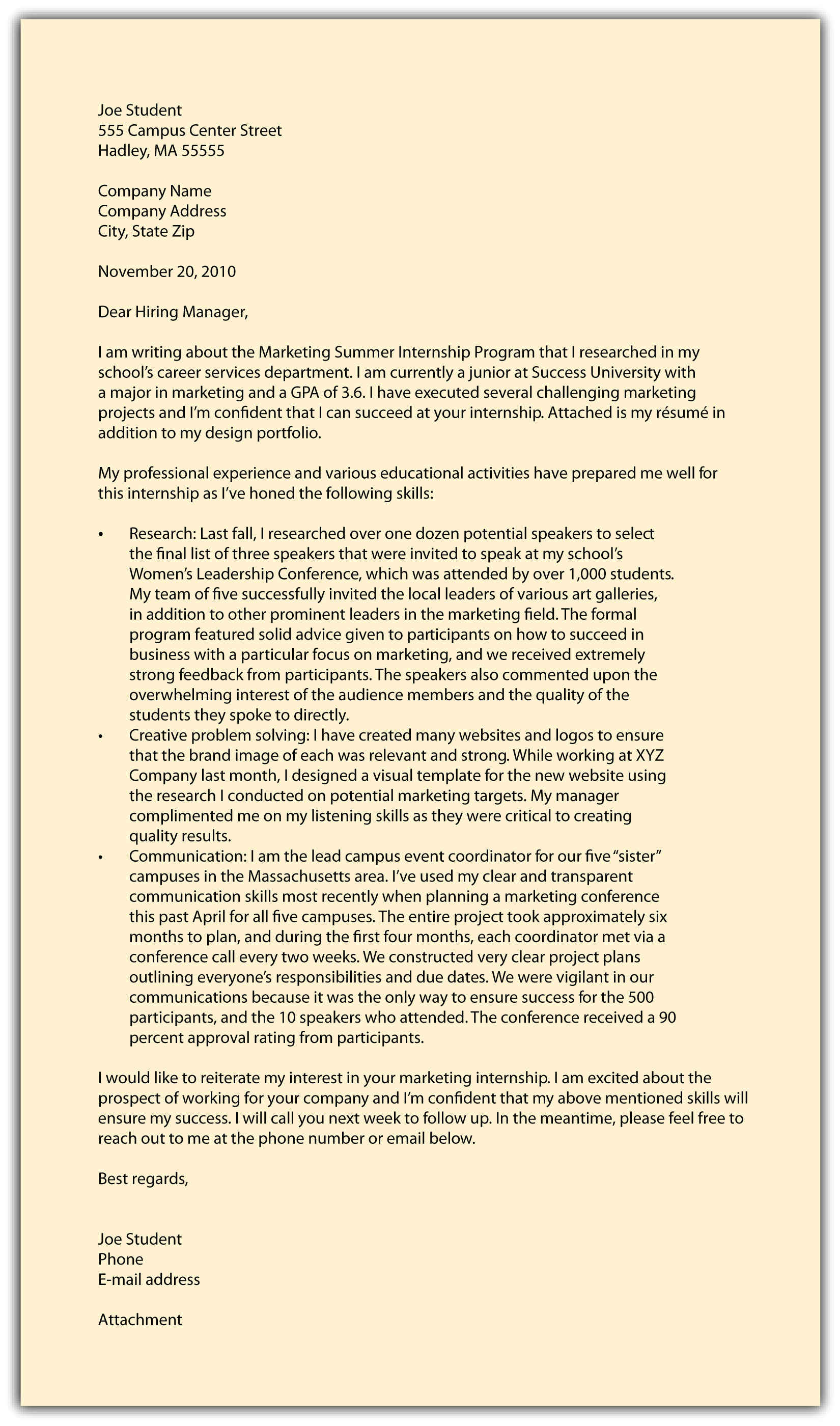
Figure 5.3 Cover Letter Sample 2
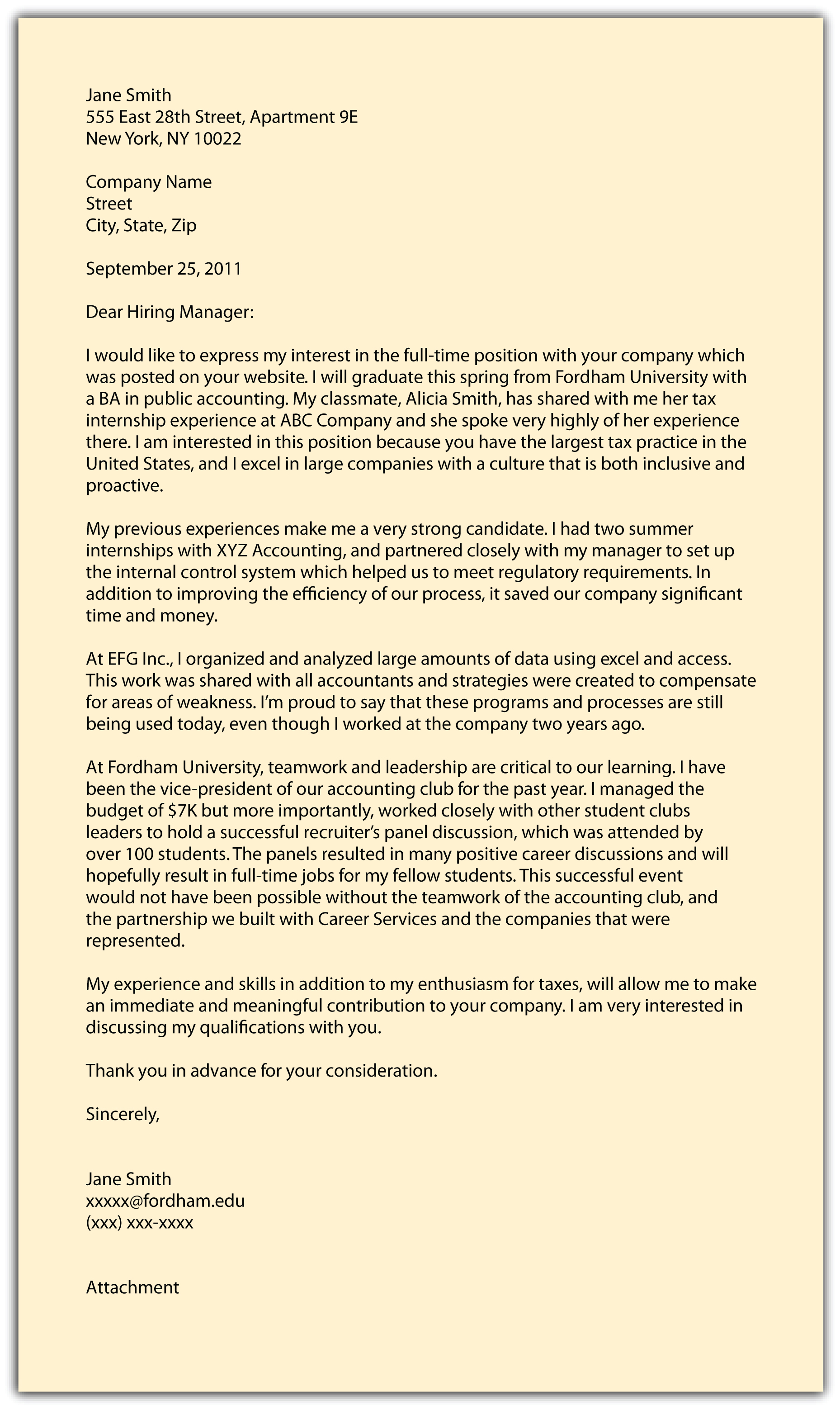
Creating a Portfolio: Show and Tell
If you have examples of your expertise in a particular discipline, consider creating a portfolio of that information to share with potential employers. For example, perhaps you are a communications major and have written several documents that showcase your talent in this area. Include five or six samples of your communications to help build the case for why you should be hired. Perhaps you are a graphic design candidate, and you created several visuals that were used by neighborhood businesses, or for a class project. Include those visuals in a portfolio to help prove your talent to a future employer.
How would you share this information with future employers? You can either attach your samples, along with your résumé and cover letter, in your e-mail to a future employer, or bring them with you when you have secured an interview. Either method is an acceptable way to impress a future employer. A portfolio that you can carry to an interview could simply be a neat and professional-looking folder that contains hard copies of your work. Or you can include a virtual portfolio of online work with a link an employer can use to view your samples. You can include this information in a cover letter and you can also include it in a résumé. Either way, having samples and presenting them can prove to future employers that you have the talent to succeed.
Miscellaneous Things to Consider
Format
Formatting is important and must be neat and professional. It’s recommended that you flush all text to the left, as various software programs can wreak havoc with indentations and tabs.
Greeting
Put extra effort into identifying the name of the hiring manager, so that your letter can be appropriately addressed to the specific person who will be reviewing résumés. Employers do not make this an easy step for you, and you have to do your research. Helpful exercises include researching the company website, reading news releases, and even calling the company to ask. Laziness will hurt your job search effort if this special effort is not made. If, after doing all the preceding, you still do not know the name of the person to whom you are sending your information, by all means, address it using Dear Hiring Manager or Dear Recruiter.
Key Takeaways
- A cover letter should not repeat a résumé.
- You need to specifically align your strengths with the job qualifications to create a compelling cover letter.
- A cover letter includes three things: the introductory paragraph, the closing paragraph, and the magic middle, where you highlight how your strengths align with the job.
- Simple is best when considering a cover letter format.
Exercises
- What are your top ten strengths, and what examples will you use to prove those strengths?
- Identify three to five weaknesses (or areas you’d like to strengthen). Create a plan to strengthen each of your weaknesses.
- Find a job description that interests you and decipher it into each individual skill.
- Find at least two to three job descriptions where you are a strong match.
- What resources can you use, in addition to this textbook, to write your cover letter?
- Draft your cover letter and pair up with a peer in your class and critique each other’s letters.
5.2 The Online Profile
Learning Objectives
- Learn why an online profile can help your job search.
- Be knowledgeable about all aspects of having an online presence.

Your online profile is the third component of a compelling marketing campaign. An online profile serves two functions:
- It’s a marketing tool for the passive job search because the majority of recruiters use online profiles to find qualified candidates.
- It’s a great networking tool because you can connect with friends, family, former coworkers, and current schoolmates and stay in touch with them easily regardless of where you or they live or work.
Digital Dirt
Various social networking sites allow you to post anything you would like in cyberspace. Twitter, Facebook, and Second Life are a few examples. Four hundred million individuals have a Facebook presence, which enables them to connect and reconnect with current and past friends. Facebook allows you to post pictures of yourself, your friends, your animals, your vacation, and anything else you would like to include. You can post your birthday, your relationship status, your taste in music, and your interests and hobbies. Most employers look to LinkedIn for professional information because LinkedIn is often described as the professional version of Facebook, but employers still will look at your Facebook profile. When three candidates seem equally suited for a position, researching the candidates on Facebook may provide information that becomes the deciding factor. A word to the wise: Ensure that information on your Facebook page can only help your job search. Foul language and inappropriate pictures of social parties and activities will hurt your ability to land the job you are seeking. Do not rely on privacy settings that you think filter individuals from viewing your information because those settings have often failed job search candidates. Facebook remains a wonderful tool for social networking, however, once something is in cyberspace, it’s virtually impossible to delete, so proceed with caution!
Overview of LinkedIn
More than 100 million people are on LinkedIn, the leading online network for professional profiles, and that number grows every day. LinkedIn is different from Facebook because it’s intended only for professional use and to focus on your career. To get started with initial online marketing efforts, LinkedIn is a great first step.
Visit LinkedIn at http://www.linkedin.com and follow the tutorial to learn aspects about the site and create an account. Use a thumbnail sketch of your résumé for your profile. Create a summary section, and bear in mind that this is a great place to include specific keywords on which recruiters and employers may search (e.g., specific technical skills, languages, brand-name companies, industry knowledge).
Who Can You Link To?
Think of ten to twenty people you’d like to connect to, such as peers from past jobs, friends and family, and peers at school. Go line by line through your résumé and think of all the people you know from each stage in your career. You can use the LinkedIn search function to search by school, organization name, or other keyword. As you populate your profile, LinkedIn makes recommendations for people you may know based on the names and keywords you enter. This gives you additional ideas for connections.
Send an invitation to the ten to twenty people you’d like to connect to. Write a personalized request to connect that reminds them how you know them, rather than using the generic templates that LinkedIn provides. With LinkedIn, all the people connected to a profile are visible to people who view that profile (you can shut off this feature, but it is helpful for networking, so most people do not). This means that for your connections, you can see their connections. This also means that the more people you are connected to, the more profiles you can view and the more your profile can be viewed. Increasing your connections improves your marketing reach.
On a regular basis, think of another ten to twenty individuals you can connect to and invite them. You can also upload some contact databases and e-mail accounts, such as Outlook, Yahoo!, and Gmail, into LinkedIn so that you can invite your entire existing network in one effort. Some open networkersPeople who choose to network with any individual, regardless of whether they know them well, or if they know them at all. will link to anyone who requests a link, or they will reach out to a variety of individuals they don’t know and ask to link to them. Either way is acceptable and whether you link only with people you know well or are willing to link with people you barely know or don’t know depends on your comfort level.
Having your résumé details in your LinkedIn profile and connecting to people is the bare minimum for an online profile. To have a profile that is a comprehensive marketing platform, you should consider the next sections, which detail additional options.
Include a Professional Picture or Head Shot
Professional photos are helpful as you start meeting more and more people because some people may remember your face more easily than your name or background.
Add a Summary to Your Thumbnail Sketch
Your LinkedIn profile is basically a thumbnail sketch of your résumé. It’s important for you to include a short, succinct summary of your background and where you are now in your career. You should also include each school you’ve attended, along with the years. Include each work experience you’ve been a part of, again, along with the years, in a professional and formal format. This will allow individuals to identify how they have known you in the past.
Include Recommendations
Include recommendations from two or three individuals who know your work. You must be connected to people to request they provide a recommendation. Recommendations help your marketing because they add a dimension to your profile that is not included in your résumé.
Join Groups
Join groups with which you share a common interest. Groups are formed from common associations, such as college alumni groups (be sure to join your school’s alumni group, even if you’ve yet to graduate), industry groups, and mutual goal groups, such as people interested in finding employment. Groups enable you to connect to more people, translating into even more people who will see your profile. You can join approximately fifty groups, and you can also elect to have your group memberships displayed or not displayed on your profile. Tailor your groups to reflect specific professional interests as another way to market yourself as being involved with that area.
Use Applications
Use LinkedIn applications such as reading lists and presentation or blog sharing. With a paper résumé, it is unwieldy to include a lot of attachments, such as a portfolioA collection or group. A portfolio of your work for job search purposes might include published articles if you are a writer or illustrations and designs if you are a designer. of your work. An online profile allows you to link to an online collection of your work and create a comprehensive view of everything you offer. You can share a list of what you are reading with the Amazon reading list application. Listing books related to your career targets shows that you are staying current about your target industries and functions and are committed to training and development. You can use the SlideShare application to post PowerPoint presentations you have created. Perhaps as part of a class assignment, you have done a group project that is relevant to prospective employers. If you have a blog and your blog showcases examples of your work, your LinkedIn profile can be set to update with samples of your work whenever you post to your blog. While this level of detail seems onerous for a paper résumé, when online it is easy to page through and access as much data as you’d like, so you can offer the reader (in this case, recruiters and employers) much more information.
Maintain Your Profile
Remember that it is important to maintain your online profile. Continually update your LinkedIn profile because as your career grows and changes, so should your LinkedIn profile. Link to new people you meet. Update your summary and experience. LinkedIn also has a status section for more frequent updates that are broadcast to your connections. In this way, you can market your activity on an ongoing basis.
Key Takeaways
- Social networking sites have both benefits and disadvantages. Make sure anything you put in cyberspace only supports your job search efforts.
- Take special care to ensure your Facebook presence gives a positive impression to anyone who may view it.
- LinkedIn is an online network with over 100 million users worldwide and provides specific connections for career-related and professional networking.
- Recruiters and employers use LinkedIn to search for candidates, making it a key marketing tool for a passive job search.
- At a minimum, you should have your résumé details online and start connecting with people.
- For a comprehensive campaign, you should also include a professional photo, recommendations, group memberships and the resulting connections and applications, such as reading lists, presentations, or blogs, that demonstrate your expertise.
Exercises
- Look up five or six individuals on http://www.linkedin.com who are employed in the industry you are most interested in joining. What have you learned from their profiles?
- Create an account on LinkedIn (if you don’t already have one).
- Connect with ten to twenty individuals.
- Think of one or more additional features on LinkedIn you will add to your marketing campaign.
5.3 Your Networking Pitch
Learning Objectives
- Learn the key components of an effective pitch.
- Follow a template to craft your individual pitch.
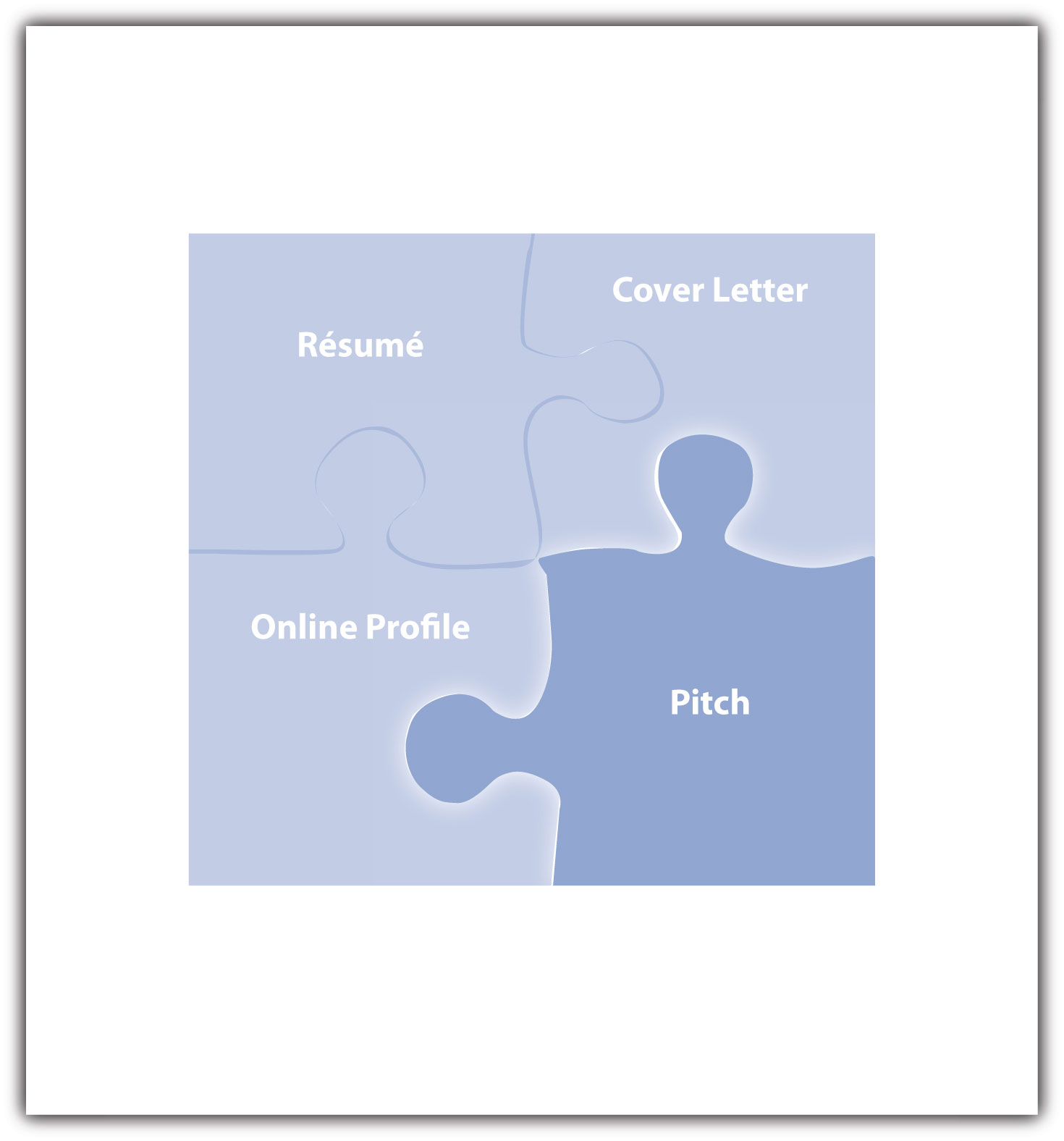
A networking pitch was originally termed an elevator pitch because in the time an elevator takes to go between floors (generally thirty to forty seconds), you should be able to articulate your value proposition (the skills you have and the position you are seeking). The elevator pitch is now also called the professional pitch, the networking pitch, or simply the pitch.
This thirty- to forty-second summary should be spoken, or delivered, in a confident and convincing manner, making a strong impression. If your pitch is too long and drawn out, it lacks conviction. When meeting networking contacts, recruiters, and hiring managers, this is your one chance to make a great impression and present yourself with clarity. No one wants to listen to a long, drawn-out speech. Make your pitch clear and concise, enabling the person who is listening to know exactly what type of job search candidate you are.
How do you craft an effective pitch? Three steps will ensure your success:
- Write your pitch.
- Edit your pitch until it sounds just right.
- Practice delivering your pitch verbally, and further edit it as needed because we do not write the same way that we speak. Continue rehearsing and repeating your pitch to ensure that your delivery is natural, convincing, and authentic.
Any information you can share that distinguishes you from others is very helpful. Perhaps you have something unique in your background:
- You speak two or three languages.
- You lived abroad for a particular length of time.
- You achieved something significant athletically or musically.
- You volunteered in a meaningful way and perhaps raised extraordinary funds for various charities.
Distinguish yourself from others in whatever way you can to ensure you are remembered in a positive light.
You will deliver your pitch at different times and occasions, including the following:
- Career fairs present an opportunity to meet representatives from various firms. These individuals will meet many students or candidates, so it is important that you make sure your pitch is short and crisp. Also be certain to do your research on their company, as many candidates do not.
- Networking events enable you to first meet someone in a more relaxed setting.
- Interviews often begin with the interviewer asking for a summary of your background or asking that you take one or two minutes to let them know about you. Include high-level themes in your past (e.g., you’ve always been involved in health care at some point in your schooling and in your career). If themes are not apparent, talk about your achievements and the quality of your efforts.
Step 1: Write Your Pitch
Your pitch should answer the following five questions:
- What is your educational background? Detail every college or university you attended, your major and minor, and your expected degree and graduation month and year (include your GPA if it is 3.3 or higher).
- Do you have any pertinent experience in the field in which you are interested?
- What are your critical skills and strengths? Highlight your top two or three skills.
- What do you want to do? Be specific regarding industry, function, and geography (see Chapter 3 "Step 1: Identify Your Job Search Targets").
- Why would you be good at the position? Focus on presenting your top two or three skills, and the skills you have that are necessary to succeed at the job you are targeting.
Type the answers to the preceding five questions, filling one complete page (8½ × 11).
Step 2: Edit Your Pitch
Once your pitch is written, review and edit it accordingly. You should use words that come naturally to you because the more natural the delivery, the more impressive the pitch. Here are some steps you can consider while editing your pitch:
- After you edit the one-page answers to the pitch questions, ensuring that you’ve covered all the important items, cut it to half a page; this forces you to prioritize the essential elements.
- After you edit the half-page document, ensuring that you’ve covered all the important items, cut it in half again (it’s now one-quarter of the page); this forces you to be even more ruthless in prioritizing.
- After you edit the quarter-page document, ensuring you’ve covered all the important items, cut it in half again, leaving only four or five key bullets; this forces you to be concise and select just the most important items.
Step 3: Practice Delivering Your Pitch
Once you have the final pitch in writing, you’ll need to practice, then practice, then practice some more. Your pitch should be spoken in a confident and compelling manner.
- Deliver your speech out loud to ensure it flows smoothly and addresses your career highlights. Practice it until you have it memorized. Practice until you can repeat it when someone shakes you from your sleep at 3:30 in the morning and you maintain your passion when saying it.
Figure 5.4 "Sample Pitch 1" through Figure 5.7 "Sample Pitch 4" are four sample pitches.
Figure 5.4 Sample Pitch 1
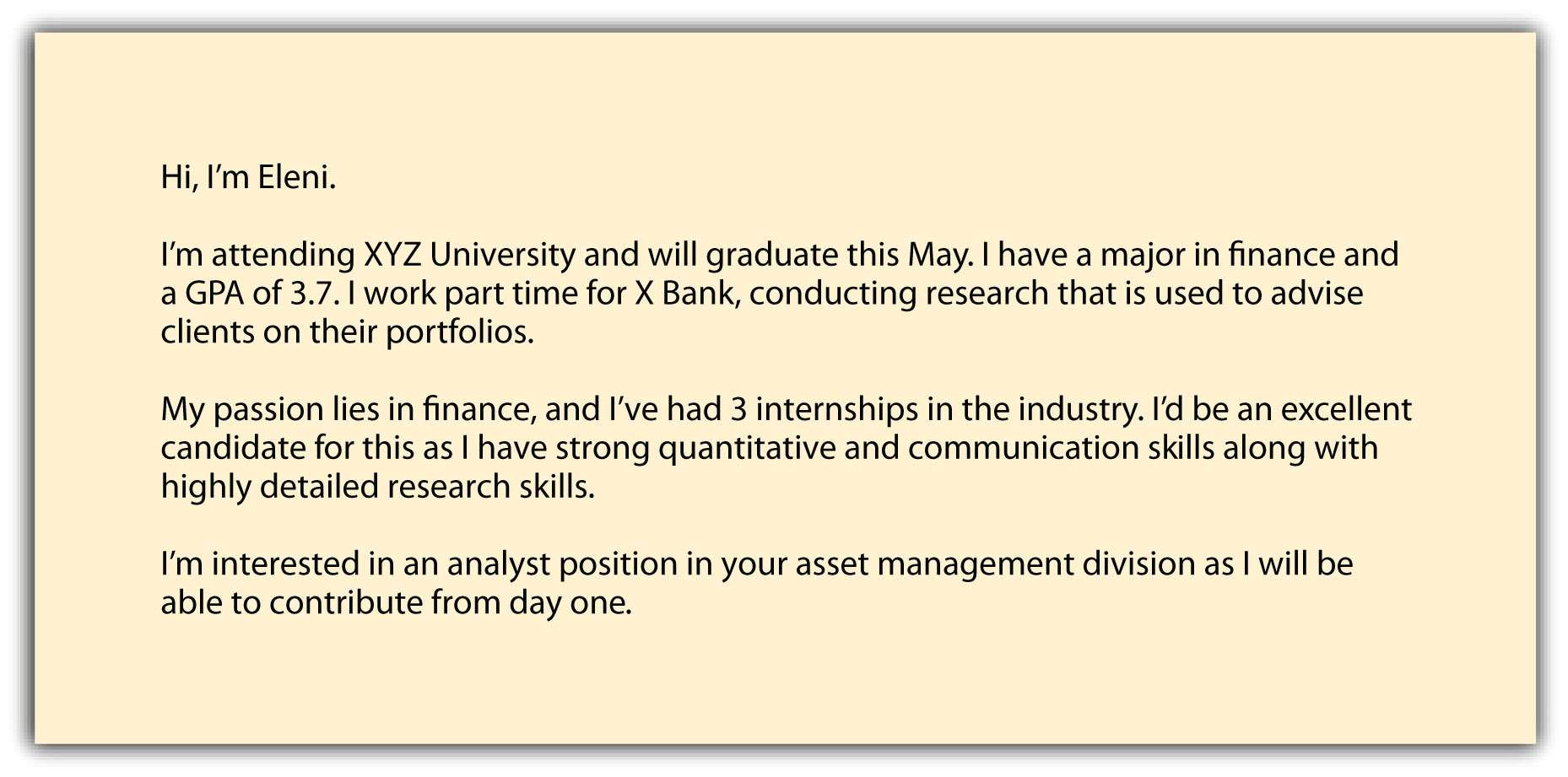
Figure 5.5 Sample Pitch 2

Figure 5.6 Sample Pitch 3

Figure 5.7 Sample Pitch 4
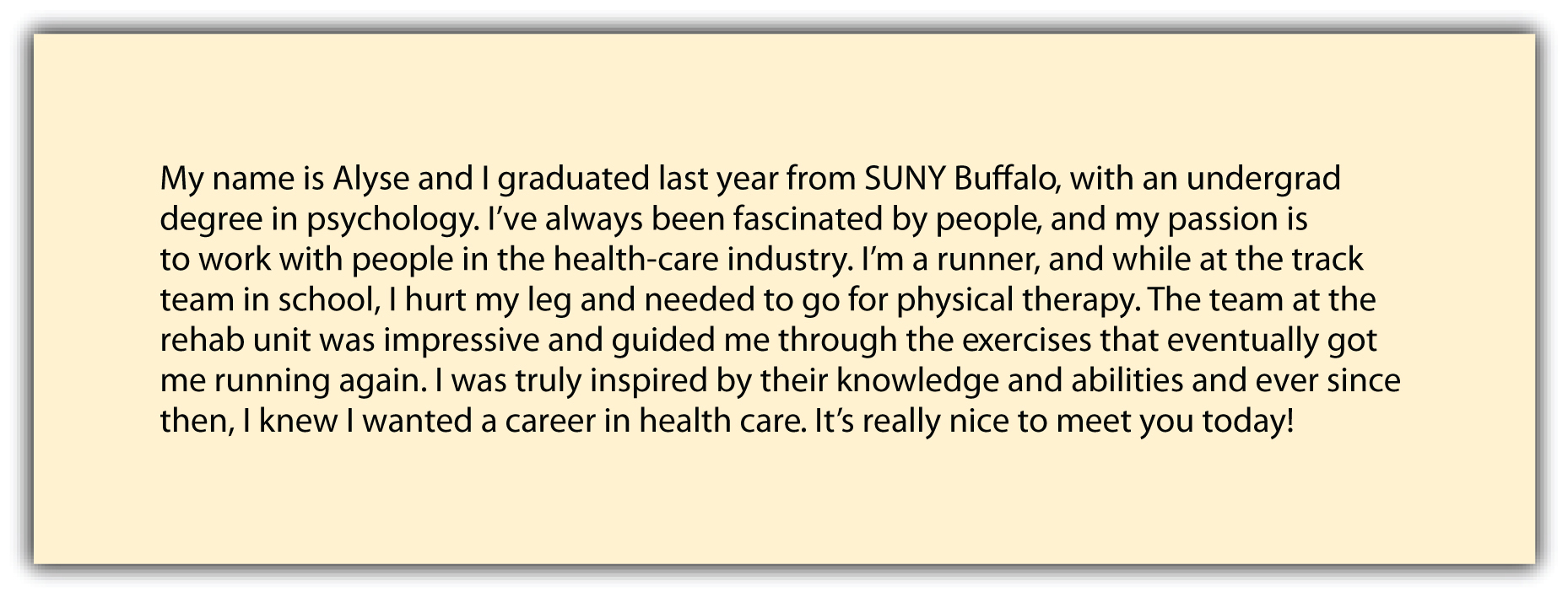
Key Takeaways
- A networking pitch articulates your value proposition (i.e., the skills you have that match the position you are seeking).
- Your pitch should contain your education background, experience related to the field in which you are interested, your critical skills and expertise, what you want to do, and why you would be good at it.
- Writing your pitch and editing it will enable you to get the right content and tone.
- Practicing the delivery of your pitch will ensure your delivery is natural and confident.
Exercises
- Type your pitch on a one-page document, and trim it until it’s just four or five bullets in length.
- Pair up with a pitch buddy to practice with each other and critique and strengthen your pitch. Does your buddy understand your value and what you want to do? Does your buddy’s pitch give you any ideas on how to improve yours?
- Practice your pitch until you can say it naturally, without any hesitation.
5.4 Chapter Review and Exercises
Creating a compelling marketing campaign is a vital step in your job search because it markets your skills and abilities to future employers, in most cases, before you meet them. The four components of this step are the following:
- Creating a résumé
- Writing a cover letter
- Creating an online profile
- Composing a pitch
Your marketing campaign will be more effective when you are more specific, targeted, and thoughtful of how to construct your marketing campaign elements:
- Your résumé will prove your success with your past employers, which then proves your worth to your future employers.
- Your cover letter makes the case for why you should be hired because it highlights the two or three critical skills necessary to succeed in the job you are seeking.
- Your online profile works behind the scenes to ensure you are seen by recruiters who seek talent. In addition, your profile provides a great way to stay connected with your network.
- Your pitch allows you to introduce yourself in a clear and concise way, highlighting the strengths you have that will enable you to succeed.
Remember that the better you market yourself, the more successful your job search will be. Apple’s marketing campaign leaves no doubt about the quality of what they offer. You should do the exact same!
The next step, step 3, is research, which will help you gather vast amounts of information about your industry, your function, your geography, and the companies you are targeting.
Chapter Takeaways
- Creating a compelling marketing campaign is vital to your job search and is composed of four things: a résumé, a cover letter, an online profile, and a pitch.
- Your marketing campaign must have high-quality standards because it represents you when you are not there.
- Even though some recruiters do not read cover letters, it is always worthwhile to write a compelling cover letter, just in case the recruiter who reviews your information values them.
- You should do five things before writing a cover letter: (1) assess your strengths, (2) assess your weaknesses, (3) decipher the job description, (4) compare your strengths, weaknesses, and the job description for alignment, and (5) select the top three skills you will include in your cover letter.
- The cover letter template includes three sections: (1) the introductory paragraph, (2) the last paragraph, which reiterates your interest, and (3) the magic middle (which highlights your top three skills).
- Your online profile serves two functions: (1) it’s a passive job search strategy because recruiters search online profiles, and (2) it’s a great networking tool because you can connect with friends, family, former coworkers, and current schoolmates and stay in touch with them easily regardless of where you or they live or work.
- A pitch should be short (less than one minute), concise, and include the following: (1) your educational background, (2) any pertinent experience in the field in which you are interested, (3) your critical skills and strengths, (4) what you want to do, and (5) why you would be good at it.
Chapter Review
- Why is quality so important when crafting a marketing campaign?
- Why is it important to assess your strengths and weaknesses when preparing to write a cover letter?
- Why do you need a cover letter when some recruiters don’t read them?
- How do you decipher a job description? How do you identify most important criteria needed for this position?
- What are the three main parts of a cover letter?
- What are the two main benefits to having an online profile?
- What is the minimum to get started with an online profile? What are some useful additional features?
- Why is a pitch important to your job search?
- What components are included in your pitch?
- Why should your pitch be short?
- Why do you have to practice your pitch?
SuccessHawk: Cover Letters
To get started on preparing cover letters, thank-you notes, and references, go to the menu bar on the right and click on Letter Templates.
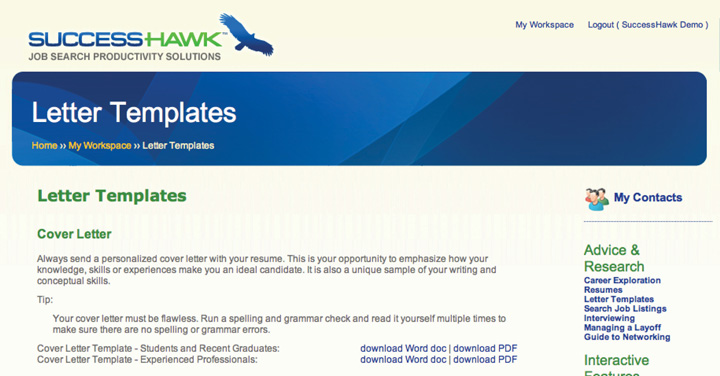
SuccessHawk: Networking Pitch
For assistance in writing your personal statement, go to the menu bar on the right, and click on Personal Statements.

5.5 Sample Cover Letters
Figure 5.8 Sample 1—Brian Thanis
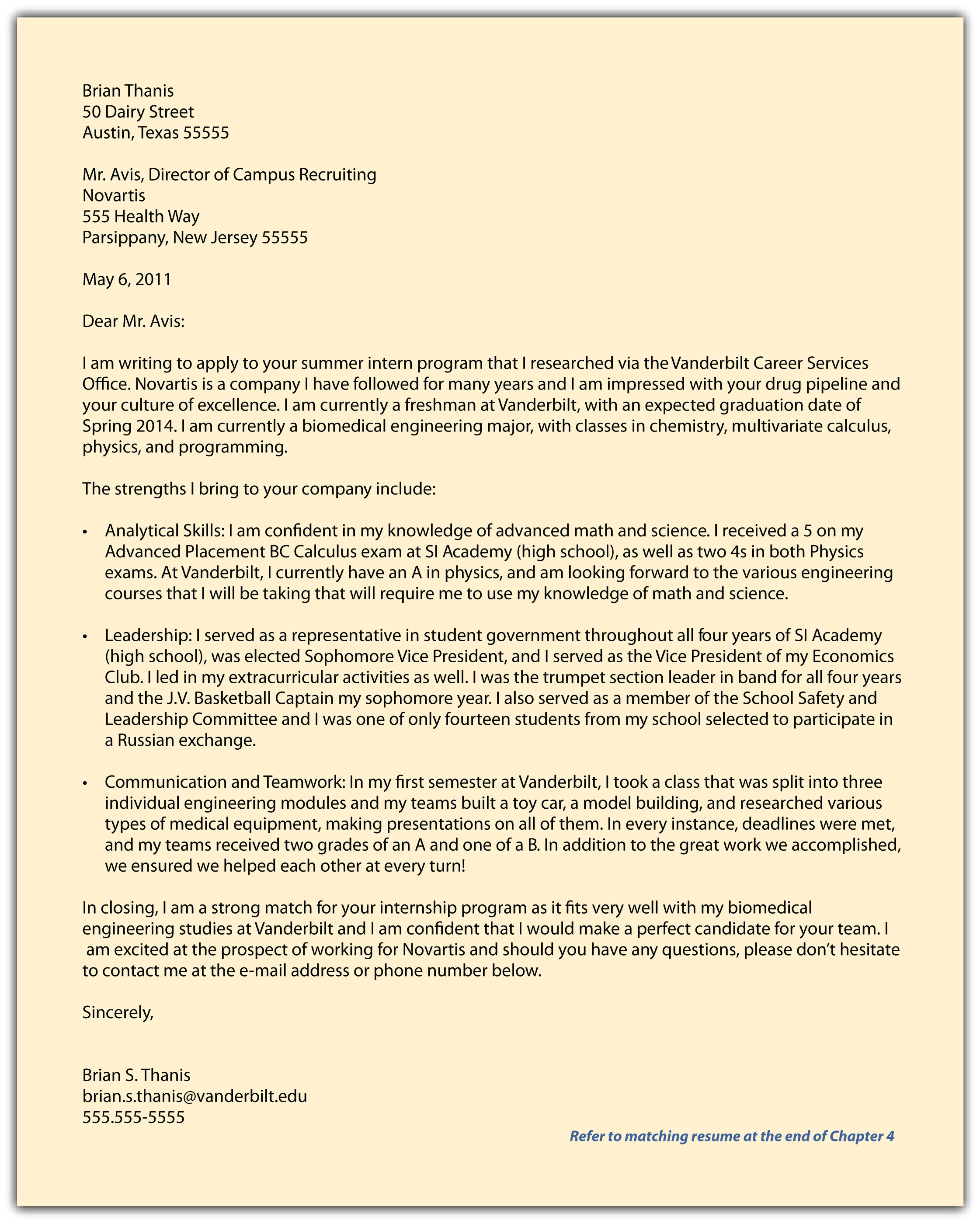
Figure 5.9 Sample 2—Alyse Day
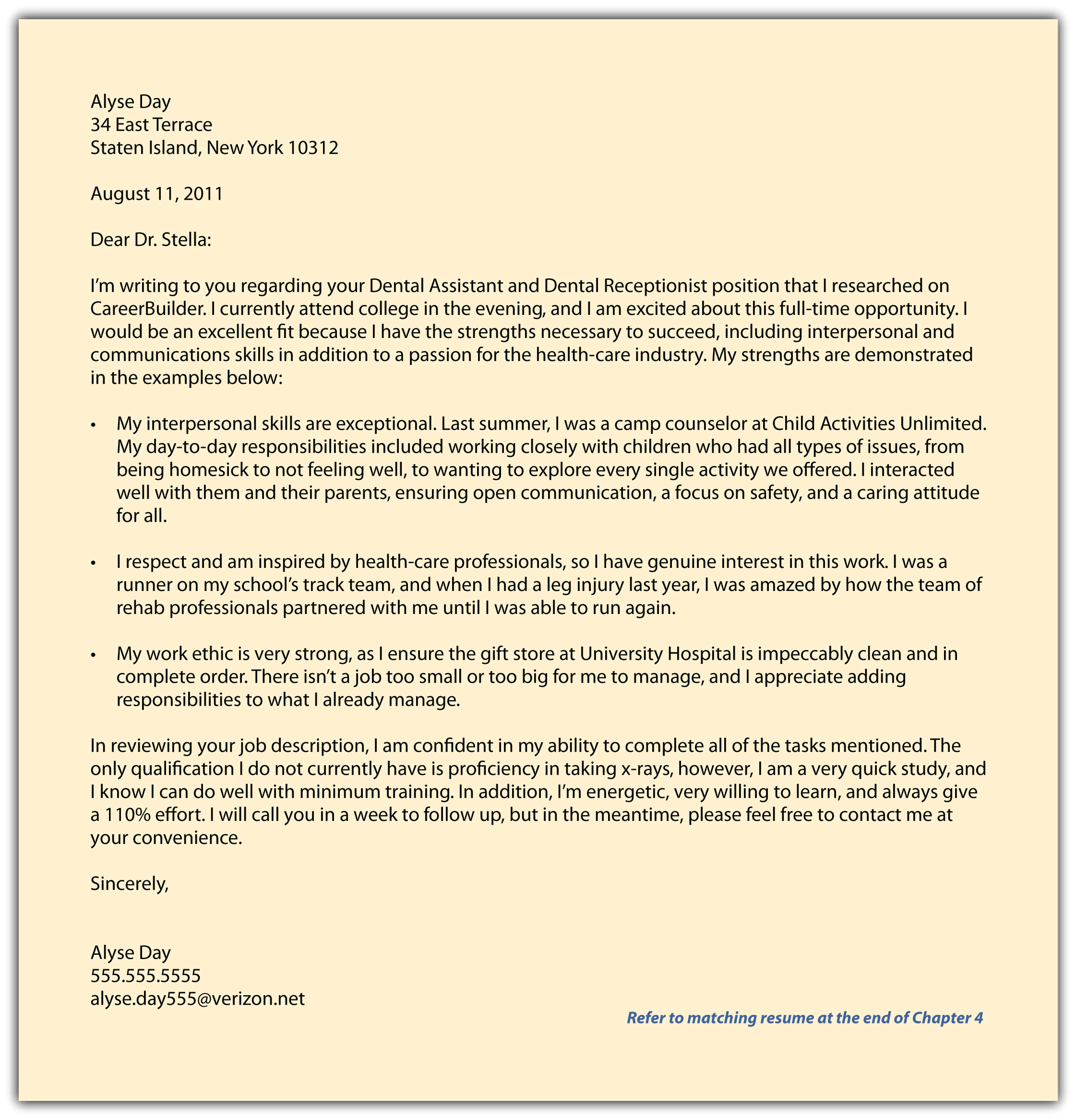
Figure 5.10 Sample 3—Louise Ng

Figure 5.11 Sample 4—Helen Patty
